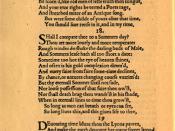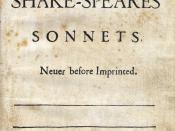ANALYSIS
Sonnet 130 is Shakespeare's rather lackluster tribute to his Lady, commonly referred to as the dark lady because she seems to be non-white (black wires for hair, etc). The dark lady, who ultimately betrays the poet by loving other men, appears in sonnets 127 to 154. Sonnet 130 is clearly a parody of the conventional and traditional love sonnet, made popular by Petrarch and, in particular, made popular in England by Sidney's use of the Petrarchan form in his epic poem "Astrophel and Stella". If you compare any of the stanzas of that poem with Shakespeare's sonnet 130, you will see exactly what elements of the conventional love sonnet Shakespeare is light-heartedly mocking. In sonnet 130, there is no use of grandiose metaphor or allusion -- he does not compare his love to Venus; there is no evocation to Morpheus, etc. The ordinary beauty and humanity of his lover are what is important to Shakespeare in this sonnet, and he deliberately uses typical love poetry metaphors against themselves.
In Sidney's work, for example, the features of the poet's lover are as beautiful and, at times, more beautiful than the finest pearls, diamonds, rubies, and silk. In sonnet 130, the references to such objects of perfection are indeed present, but they are there to illustrate that his lover is not as beautiful -- a total rejection of Petrarch form and content. Shakespeare utilizes a new structure, through which the straightforward theme of his lover's simplicity can be developed in the three quatrains and neatly concluded in the final couplet. Thus, Shakespeare is using all the techniques available, including the sonnet structure itself, to enhance his parody of the traditional Petrarchan sonnet typified by Sidney's work. But Shakespeare ends the sonnet by proclaiming his love for his mistress despite her lack...



Sonnet 130
I like this essay, but disagree with your description of this as a 'lacklustre tribute'. Personally I read this to be a response to those poets using overblown imagery to describe their love. He is forcefully putting forward his love which is grounded in reality and without fancy. I would have liked to see a little more on the language used, but this was very well written
2 out of 2 people found this comment useful.